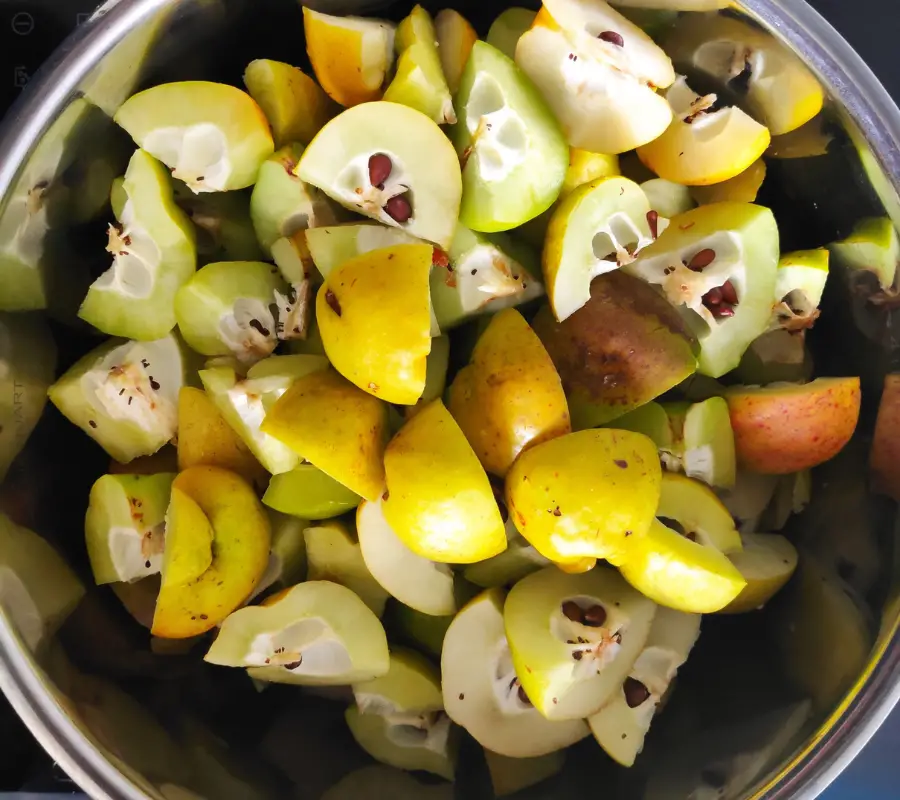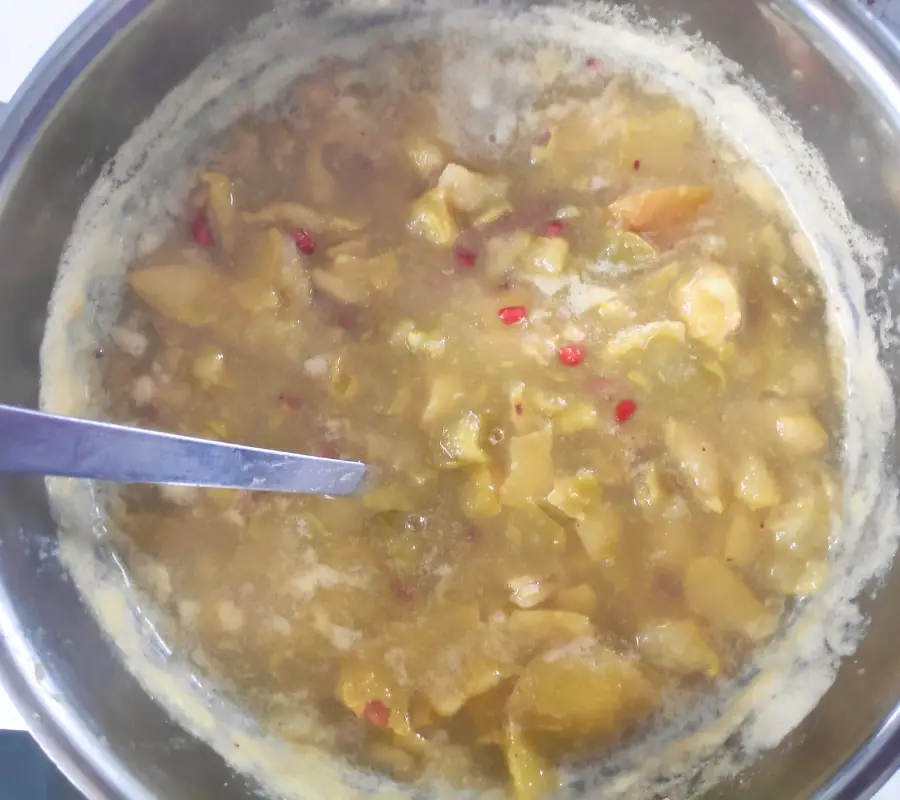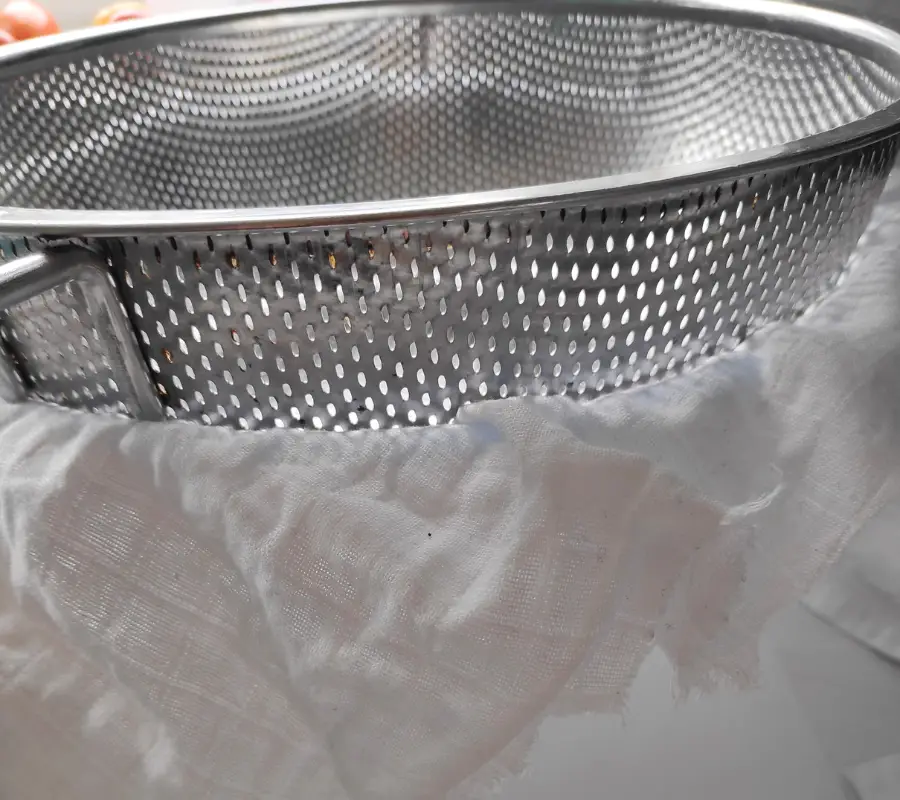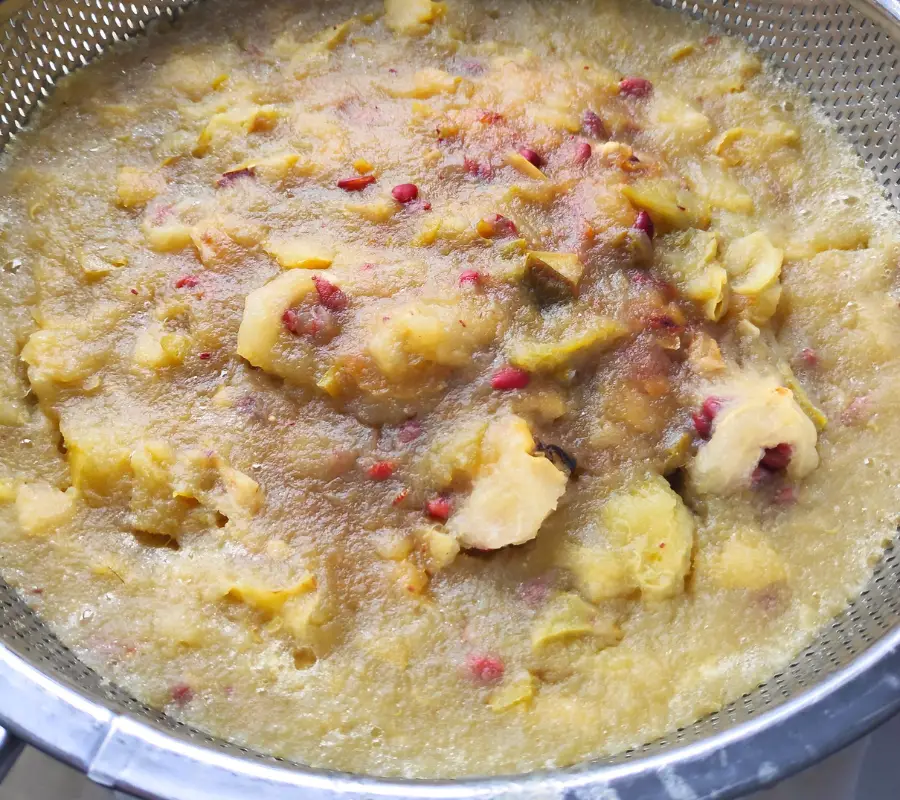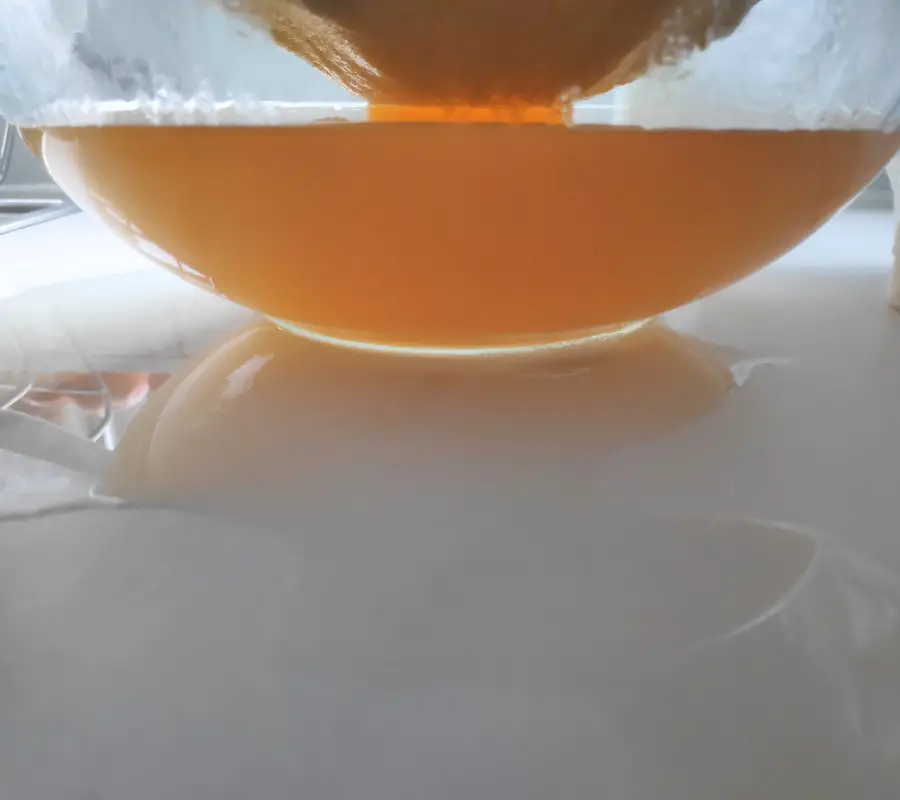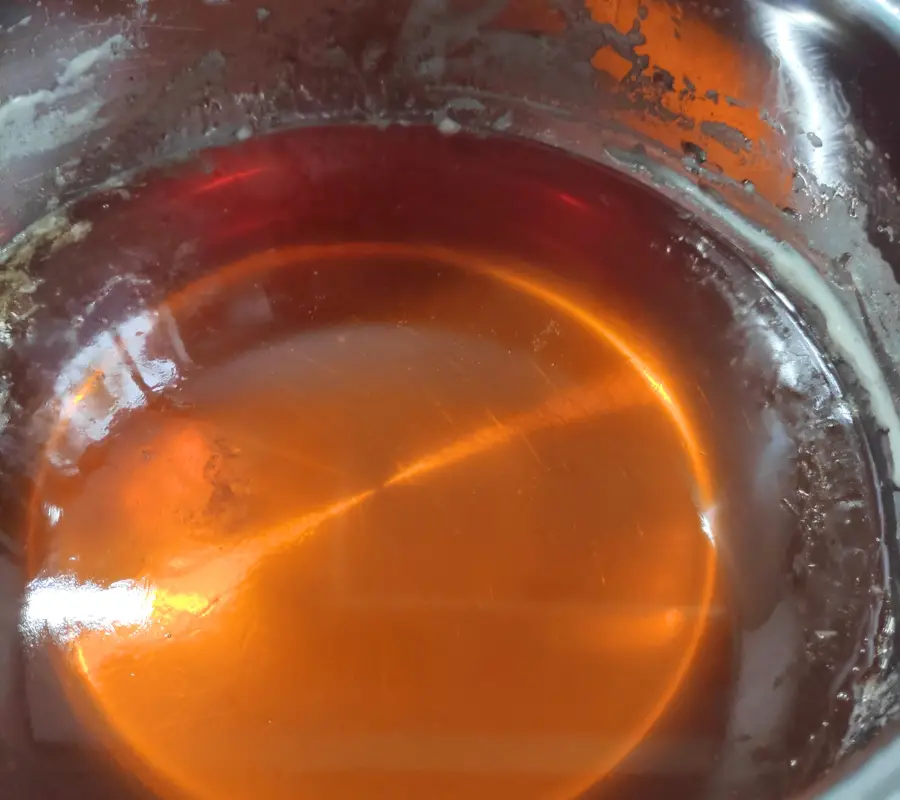Easy British Quince Jelly Recipe (2 Ingredients)
Quince jelly is a delicious and versatile spread that has been enjoyed for centuries. Made from only two ingredients – quince and sugar – it is a simple yet elegant preserve that can be used in a variety of ways. Whether you spread it on toast, use it as a glaze for meats, or add it to your cheese board, quince jelly is a must-try for any food lover.
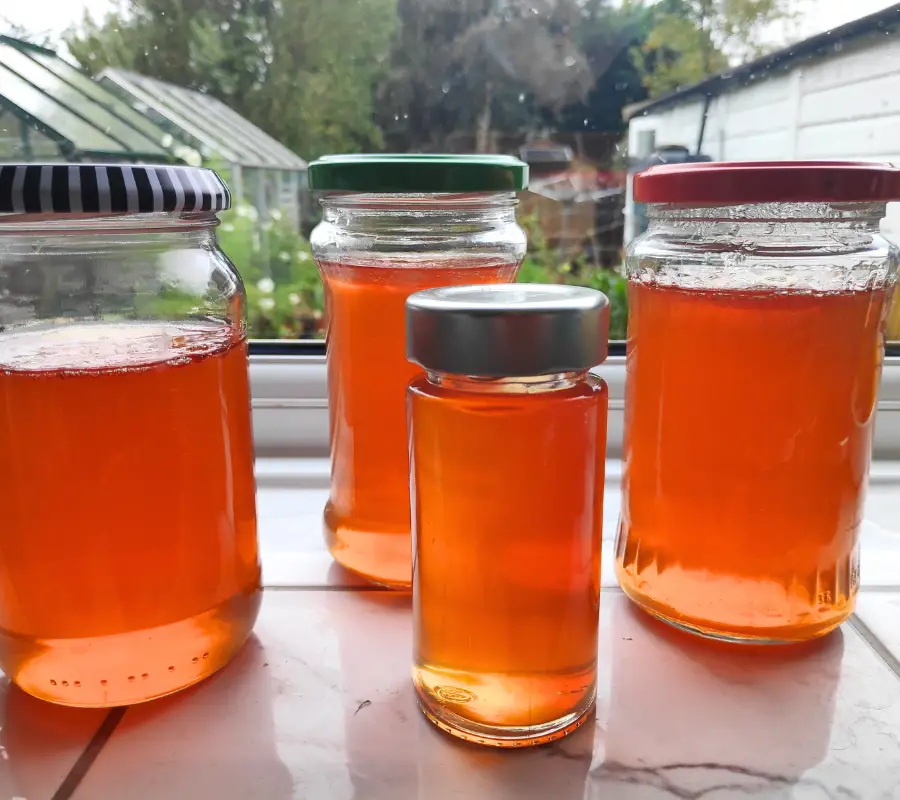
Table of contents
Why You’ll Love This Recipe
- Quince jelly is a simple yet elegant preserve made from only two ingredients – quince and sugar.
- The origins of quince jelly can be traced back to ancient Greece, and it has been a popular ingredient in Middle Eastern and Mediterranean cuisine for centuries.
- Quince jelly is a versatile spread that can be used in a variety of ways, from spreading it on toast to using it as a glaze for meats.
- It produces a natural pectin – great for adding to jams that don’t have as much.
- You will love the colour!
Ingredients For Quince Jelly Recipe
- 2 kg Quinces – Roughly chopped, no need to peel or core
- 1.25 litres Water
- 1 kg Sugar (Granulated )
How to make quince jelly
STEP 1:
Wash the quinces and cut off any bad bits. Cut into chunks or slices (no need to peel or core). Place in a large stainless steel pot and add the water.
STEP 2:
Bring to the boil, then reduce the heat for about 30 minutes until mushy.
STEP 3:
Line a colander with a muslin cloth or jelly bag and set it over a large bowl. Spoon in the quince mixture without pressing down and allow to stand for at least 4 hours or overnight until all the juices have dripped out.
STEP 4:
Measure the quince juice into a clean stainless steel saucepan, and for each 250ml/1 cup juice, add 200g/1cup sugar. Heat gently until the sugar has dissolved, then increase the heat to boiling point.
STEP 5:
Continue to boil until the mixture reaches 105°-110°c (220-225°f). After 15 -20 minutes test to see if it’s ready take a cold plate from the fridge and add a small amount, and wait for a few minutes. It should wrinkle with your fingertips when ready. (the wrinkle test).
STEP 6:
Skim away any excess froth and discard.
STEP 7:
Pour into hot sterilised glass jars. Seal immediately and allow to cool.
NOTE: Quince jelly doesn’t take as long to set as it would to make jam because they are full of pectin. So even if it looks runny after 15 minutes, check to see if it’s ready.
Quince Jelly: A Delicious Autumn Treat
The origins of quince jelly can be traced back to ancient Greece, where the fruit was prized for its medicinal properties. Over time, it became a popular ingredient in Middle Eastern and Mediterranean cuisine, and eventually made its way to Europe.
In Britain, quince trees were once a common sight in gardens and orchards, and the fruit was a staple in many households. Today, quince jelly is still a beloved treat, and can be found in specialty food shops and farmers’ markets throughout the country. Try my Quince Marzipan Crumble, it’s so good!
Chop the quinces into quarters. No need to peel or core Boil the quinces with water until mushy Place muslin cloth and sieve over a large bowl Add the mushy quinces to the sieve. Let the juices fall through into the bowl for 4 hours or overnight. Transfer the juice to a pot with the sugar and boil.
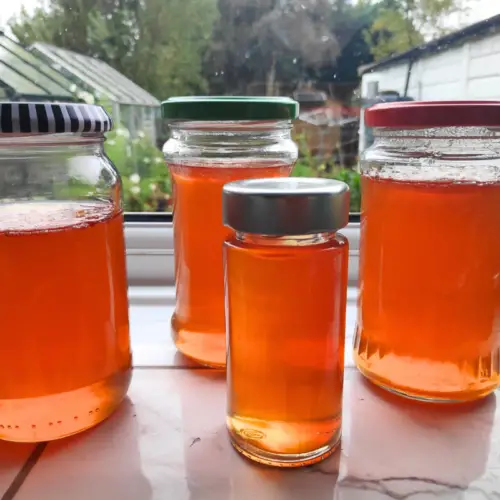
British Quince Jelly
Equipment
Ingredients
- 2 kg Quinces
- 1.25 litres Water
- 1 kg Sugar (Granulated )
Instructions
- Wash the quinces and cut off any bad bits. Cut into chunks or slices (no need to peel or core). Place in a large stainless steel pot and add the water.2 kg Quinces, 1.25 litres Water
- Bring to the boil, then reduce the heat for about 30 minutes until mushy.
- Line a colander with a muslin cloth or jelly bag and set it over a large bowl. Spoon in the quince mixture without pressing down and allow to stand for at least 4 hours or overnight until all the juices have dripped out.
- Measure the quince juice into a clean stainless steel saucepan, and for each 250ml/1 cup juice, add 200g/1cup sugar. Heat gently until the sugar has dissolved, then increase the heat to boiling point.1 kg Sugar
- Continue to boil until the mixture reaches 105°-110°c (220-225°f). After 15 -20 minutes test to see if it's ready take a cold plate from the fridge and add a small amount, and wait for a few minutes. It should wrinkle with your fingertips when ready.
- Skim away any excess froth and discard. Pour into hot sterilised jars. Seal immediately and allow to cool.
Notes
Nutrition
How To Sterilize Jars
Wash your jam jars thoroughly with hot soapy water, ideally, use your dishwasher at a high temperature. Then using a clean sink, place your jars and lids in it and pour boiling hot water over them. You may need to boil the kettle a few times, depending on how many jars you have. Leave to dry on a clean piece of clean kitchen towel.
Understanding Quince
Quince is a fruit that is in season during October. It is a yellow, pear-shaped fruit that is often used to make jelly due to its high pectin content. Pectin is a natural substance that is found in many fruits and is used to thicken jams and jellies.
When selecting quinces, it is important to choose ripe ones. Ripe quinces will have a yellow colour and will be slightly soft to the touch but usually a hard fruit.
Quince jelly is a traditional English preserve that is made by cooking quinces with sugar and water. The mixture is then strained to remove any solids and the resulting liquid is boiled until it reaches the desired consistency.
Quince jelly is a versatile ingredient that can be used in a variety of sweet and savoury dishes. It can be spread on toast or used as a glaze for meats. It is also a popular accompaniment to cheese.
The Basics of Jelly Making
Jelly making is a fun and rewarding activity that can result in a delicious spread for toast, scones, and other baked goods. To make quince jam jelly, one needs to extract the juice from a fruit, add sugar, and simmer the mixture until it reaches the desired consistency. Here are some basics of jelly making:
Ingredients
The main ingredients in jelly making are fruit juice, sugar, and water. The amount of sugar needed depends on the sweetness of the fruit and personal preference. Pectin, a natural substance found in fruits, helps the jelly set. Some fruits, such as apples and quinces, are high in pectin, while others, such as strawberries and raspberries, require the addition of pectin.
Equipment
To make jelly, one needs a large stainless steel pot, a muslin or cheesecloth, and a sweet thermometer. A sweet thermometer is used to monitor the temperature of the mixture to ensure it reaches the correct setting point.
Steps
To make jelly, the fruit is first washed, chopped, and simmered in water until soft. The mixture is then strained through a muslin cloth to extract the juice. Sugar is added to the juice, and the mixture is simmered until it reaches the correct setting point, which is usually around 105°C. To test if the jelly is ready, a small amount is dropped onto a cold plate. If it wrinkles when pushed with a finger, it is ready. The jelly is then poured into sterilized jars and left to cool.
Tips
Adding lemon juice to the mixture can help the jelly set and improve the flavour. To make jelly without commercial pectin, it is important to use fruits that are high in natural pectin, such as quinces. The cooking time and temperature are also important factors that affect the setting of the jelly. Overcooking can cause the jelly to become too firm, while undercooking can result in a runny texture.
Storing and Preserving Quince Jelly
Once the quince jelly has been made and allowed to cool, it is important to store it properly to ensure that it stays fresh and delicious for as long as possible.
Firstly, it is recommended to pour the jelly into sterilized jars while it is still hot. This will help to prevent any bacteria from growing and spoiling the jelly. It is important to leave a small amount of space at the top of the jar to allow for expansion as the jelly cools and sets.
Next, label each jar with the date it was made and the contents. This will help you keep track of how long the jelly has been stored and prevent any confusion about what is inside each jar.
For best results, store the sealed jars of quince jelly in a cool, dark place such as a pantry or cupboard. If stored properly, the jelly can last for up to a year.
If you prefer to refrigerate the jelly, it is important to note that it may become slightly firmer in texture. To prevent this, it is recommended to store the jelly in the fridge for no more than a few weeks.
Serving Suggestions for Quince Jelly
Quince jelly is a versatile condiment that can be enjoyed in a variety of ways. Here are some serving suggestions for quince jelly that will surely impress your guests.
With Cheese
Quince jelly pairs perfectly with cheese, particularly hard and sharp cheeses like strong cheddar and emmental. Simply spread some quince jelly on a cracker or a slice of bread and top it with a piece of cheese. The combination of sweet and salty flavours is sure to delight your taste buds.
With Game
Quince jelly is a popular accompaniment to game dishes, such as venison and pheasant. The sweetness of the jelly balances out the gamey flavour of the meat, creating a harmonious taste experience. Try serving quince jelly alongside a roasted game dish for a truly special meal.
On Toast
For a simple yet delicious breakfast or snack, spread some quince jelly on a slice of toast. The sweetness of the jelly pairs well with the buttery taste of toast, making it a great way to start your day.
With Pork
Quince jelly also goes well with pork dishes, such as roast pork or pork chops. The sweetness of the jelly complements the savoury flavour of the meat, creating a delicious combination. Try serving quince jelly alongside a pork dish for a flavourful meal.
As a Dessert Topping
Quince jelly can also be used as a dessert topping, ice-cream, particularly for creamy desserts like rice pudding or crème brûlée. Simply spoon some quince jelly over the dessert and serve. The jelly adds a fruity sweetness that complements the creaminess of the dessert.
On a Cheese Plate
For an elegant cheese plate, include a small dish of quince jelly alongside the cheese. Guests can enjoy a bite of cheese followed by a spoonful of jelly, creating a delicious flavour combination.
Quince jelly can also be used to make other desserts, such as quince jelly crumble or quince jelly foam. Get creative and experiment with different ways to enjoy this versatile condiment.
Variations of Quince Jelly
Quince jelly is a versatile condiment that can be made in many different ways. Here are some variations to try:
Adding Other Fruits
While quince is the star of the show in quince jelly, you can experiment with adding other fruits to give it a different flavour. For example, you could try adding apple or pear to the mix. Simply chop up the fruit and cook it with the quince, then strain it through a jelly bag as usual.
Adding Lemon Juice
Adding a small amount of lemon juice to your quince jelly can help to balance out the sweetness and give it a tangy edge. Try adding the juice of one lemon to your recipe and see how it affects the flavour.
Adding Chilli
For those who like a bit of heat, adding a small amount of chilli to your quince jelly can give it a spicy kick. You could try adding a finely chopped red chilli to the mix, or a pinch of chilli flakes.
Making Quince Paste
If you want to take your quince jelly to the next level, why not try making quince paste instead? This is a denser, more concentrated version of the jelly that is perfect for serving with cheese. To make quince paste, simply cook the fruit juice and sugar for longer until it becomes thick and sticky, then pour it into a lined tin to set.
Overall, there are many ways to experiment with quince jelly and make it your own. Whether you add other fruits, lemon juice, chilli, or turn it into quince paste, there are endless possibilities to explore.
Frequently Asked Questions
Where can I find Quince Jelly for sale?
Quince jelly can be found in many specialty food stores, as well as online retailers. Look for it in the jams and preserves section of your local grocery store or search for it on online marketplaces such as Amazon or Etsy.
What types of meat pair well with Quince Jelly?
Quince jelly is a versatile condiment that pairs well with many types of meat. It is particularly delicious with roasted pork or chicken, as well as game meats such as venison or duck. It can also be used to add a sweet and tangy flavour to cheese boards or charcuterie platters.
